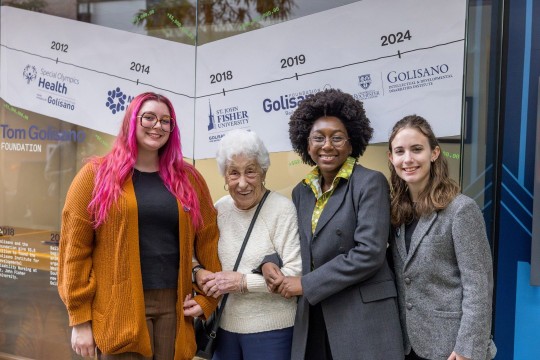Exhibit celebrates Rochester Royals team
Continues through April 22 at RIT’s Wallace Center
A poster promoting the Rochester Royals Exhibit, designed by Nicole Dombi, a fifth-year new media design major from South Burlington, Vt.
An exhibit chronicling the Rochester Royals professional basketball team opens today in Rochester Institute of Technology’s Wallace Center. The team played in Rochester from 1945 to 1957 and won the NBA championship in 1951.
“When Rochester Was Royal: Professional Basketball in Rochester 1945-1957” chronicles the Royals’ entrance to and exit from Rochester’s sporting landscape. Curated by three museum studies faculty members from RIT, the exhibition explores the team and its time at the pinnacle of professional basketball.
The exhibit, in the Sunken Gallery on the Wallace Center’s second floor, continues through April 22. It includes the team’s history through numerous photographs of players over the years, archival material including the bill of sale that gave the Royals their new home in Cincinnati, programs from several games played at Edgerton Park Sports Arena, and more.
A reception will be held at the exhibit from 5 to 6:30 p.m. Thursday, April 21, which is 65 years to the day from when the Royals captured the NBA crown.
“This spring marks the 65th anniversary of the Rochester Royals’ NBA title. It seemed the perfect occasion to reflect on the history and legacy of the Royals and their owner Les Harrison,” said Rebecca Edwards, chair of RIT’s history department and a curator for the exhibit with Associate Professor Juilee Decker and Visiting Assistant Professor Michael Brown.
The team was studded with future hall of famers including Arnie Risen, Al Cervi, Bob Davies, Red Holzman, Maurice Stokes, Jack Twyman and Bobby Wanzer. Despite the players, owner Les Harrison—one of the most energetic and dedicated owners in league history—loyal fans in an affluent city and an NBA championship, the Royals could not remain in Rochester.
The exhibition will be supported by the creation of digital ancillaries by museum studies students.
“A cornerstone of our museum studies program is working at the intersection of theory and praxis,” Decker said. “Students in my course are reading about visitor engagement and coming to understand how the space of the museum can be a platform for content as well as conversation.”
Kelli Spampinato, a third-year museum studies major from Webster, N.Y., who is part of the team who developed the exhibition, said working on it has helped her understand all of the steps of creating and executing an exhibition.
“Projects like this help take the theory we have learned in this class and others and make it practical,” she said. “Doing work in class that will actually be put to use for the public has made me feel as though my education has come full circle.”













